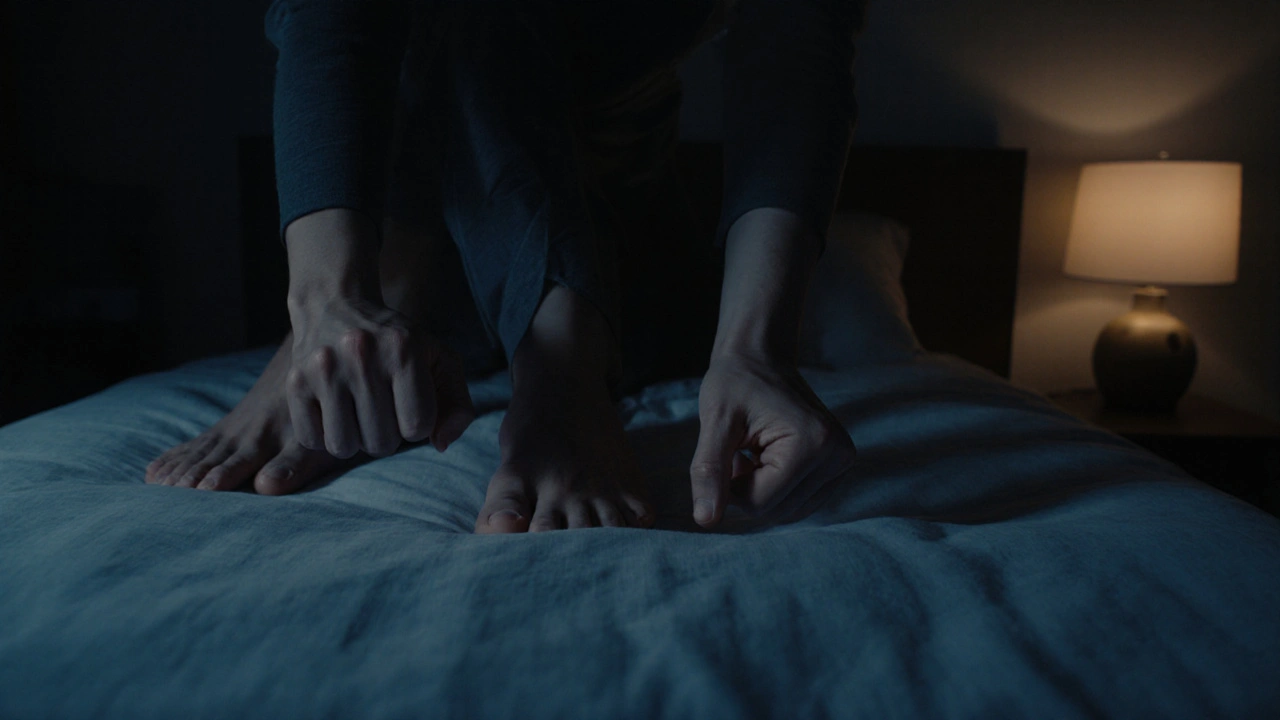Stress doesn’t take a day off. Whether it’s work deadlines, family chaos, or just the noise of modern life, your body keeps carrying it - even when you think you’ve let it go. The good news? You don’t need a spa retreat or a week in Bali to reset. Real, lasting relaxation starts with simple, science-backed techniques you can do anywhere, anytime. And no, meditation isn’t the only way.
Deep Breathing: Your Instant Calm Button
When you’re overwhelmed, your breath gets shallow. That’s your body’s fight-or-flight signal firing on low fuel. Deep breathing doesn’t just feel nice - it tells your nervous system to hit pause.
Try the 4-7-8 method: Inhale through your nose for 4 seconds. Hold for 7. Exhale slowly through your mouth for 8. Repeat four times. This isn’t just a trick. A 2020 study from Harvard Medical School showed this pattern lowers cortisol levels within minutes. You can do it at your desk, in traffic, or right before bed. No special equipment. No apps. Just your lungs.
Why it works: Slow, controlled breathing activates the vagus nerve, which slows your heart rate and signals safety to your brain. It’s like flipping a switch from panic to calm.
Progressive Muscle Relaxation: Release Tension You Didn’t Know You Had
Most people carry stress in their shoulders, jaw, or forehead - and they’ve forgotten what it feels like to be loose. Progressive muscle relaxation (PMR) helps you notice and release that hidden tension.
Here’s how: Start with your toes. Tighten them as hard as you can for 5 seconds. Then let go. Feel the difference. Move up: feet, calves, thighs, stomach, hands, arms, shoulders, neck, face. Each time, tense for 5 seconds, then release for 10. The contrast makes you aware of what relaxation actually feels like.
This technique was developed in the 1920s by Dr. Edmund Jacobson, but it’s still used today in hospitals for anxiety and chronic pain. A 2023 meta-analysis in the Journal of Clinical Psychology found PMR reduced anxiety symptoms in 82% of participants after just two weeks of daily practice. You don’t need to do the full routine every time. Even 5 minutes before bed makes a difference.
Mindfulness: Not Just a Buzzword
Mindfulness gets thrown around a lot. But it’s not about emptying your mind. It’s about noticing what’s happening - without judging it.
Try this: Sit quietly for 3 minutes. Don’t try to relax. Just notice. The sound of your breath. The weight of your body on the chair. The temperature of the air on your skin. When your mind jumps to your to-do list - and it will - gently bring it back. No scolding. No frustration. Just return.
This isn’t woo-woo. MRI scans show regular mindfulness practice shrinks the amygdala - the brain’s fear center - and thickens the prefrontal cortex, which handles decision-making and emotional control. A 2024 study from the University of Sydney tracked 300 adults using a daily 5-minute mindfulness app. After 30 days, 76% reported lower stress levels and better sleep. You don’t need to sit cross-legged. Do it while waiting for your coffee, walking to the car, or brushing your teeth.

Guided Imagery: Escape Without Leaving Your Chair
Ever been so tired you wished you could just teleport to a quiet beach? Guided imagery lets your brain fake it - and your body believes it.
Close your eyes. Picture a place that feels safe and calm. It could be a forest, a lakeside, a cozy room with a fireplace. Engage all your senses. What do you hear? Birds? Water lapping? Crickets? What do you smell? Pine trees? Salt air? Warm bread? Feel the ground under your feet. Is it soft grass? Cool sand?
Research from the Mayo Clinic shows guided imagery lowers blood pressure and reduces perceived pain in patients with chronic conditions. You can use free recordings on YouTube or apps like Insight Timer, but you don’t need them. Just close your eyes and let your mind wander to that safe place. Even 10 minutes a day can reset your stress response.
Box Breathing: The Navy SEALs’ Secret
You don’t have to be a soldier to use this. Box breathing is used by firefighters, pilots, and elite athletes to stay calm under pressure.
Inhale for 4 seconds. Hold for 4. Exhale for 4. Hold for 4. Repeat. It’s simple. It’s rhythmic. And it works.
Why? The equal timing creates a steady rhythm that overrides chaotic breathing patterns. A 2022 study in Frontiers in Human Neuroscience found box breathing improved focus and reduced anxiety in high-stress professionals more effectively than traditional meditation. Try it before a tough meeting, after an argument, or when you’re lying awake at 2 a.m.
Why Most People Fail at Relaxation - And How to Fix It
Here’s the truth: Most relaxation techniques fail not because they don’t work - but because people treat them like chores.
You can’t force calm. Trying to “do” relaxation makes it harder. Instead, think of it like watering a plant. You don’t need to do it perfectly. You just need to do it regularly.
Start small. Pick one technique. Do it for 3 minutes, once a day, for a week. No pressure. No goals. Just show up. After that week, add another. Maybe deep breathing in the morning, PMR at night. Or mindfulness while commuting.
Track it. Not with an app. Just jot down one sentence each day: “Felt calmer after breathing for 3 minutes.” Or “Didn’t clench my jaw during the meeting.” Small wins build real change.

What Doesn’t Work (And Why)
Not everything labeled “relaxation” actually relaxes you.
Scrolling through social media? That’s not rest. It’s sensory overload. A 2025 study from Curtin University found people who used their phones before bed took 27% longer to fall asleep and reported more anxiety the next day.
Drinking alcohol to unwind? It might knock you out, but it fragments your sleep cycle. You wake up tired even after 8 hours.
Waiting for “someday” to relax? That someday never comes. Relaxation isn’t a reward for being productive. It’s the foundation that lets you be productive without burning out.
Make It Stick: Build a Personal Relaxation Routine
Here’s a simple plan that works for most people:
- Morning: 3 minutes of box breathing after brushing your teeth.
- Afternoon: 5 minutes of mindfulness while eating lunch - no phone.
- Evening: 7 minutes of progressive muscle relaxation in bed, lights off.
That’s 15 minutes a day. Less than a commercial break on TV. But over a month, it rewires how your brain handles stress.
Adjust it. If you hate lying down, do PMR sitting up. If breathing feels weird, try guided imagery instead. The goal isn’t perfection. It’s consistency.
When to Seek Help
These techniques work wonders - but they’re not a cure-all. If you’re constantly exhausted, overwhelmed, or feel numb most days, you might be dealing with chronic stress or anxiety. That’s not weakness. It’s a signal.
Talk to a doctor or therapist if:
- You’re having trouble sleeping for more than two weeks
- You feel hopeless or worthless most days
- Physical symptoms like headaches, stomach pain, or chest tightness won’t go away
Relaxation techniques are powerful tools. But they’re part of a bigger picture. You deserve support when things get heavy.
Start today. Pick one technique. Try it for five minutes. Notice what changes - even a little. That’s how calm begins.
Can relaxation techniques really lower blood pressure?
Yes. Studies show techniques like deep breathing, progressive muscle relaxation, and mindfulness can lower systolic blood pressure by 5 to 10 points over time. A 2021 review in the American Journal of Hypertension found these methods were as effective as mild medication for people with prehypertension - without side effects.
How long until I feel the effects of relaxation techniques?
You can feel calmer after just one session - especially with breathing or imagery. But lasting changes, like better sleep or reduced anxiety, usually show up after 2 to 4 weeks of daily practice. It’s like building muscle. Consistency beats intensity.
Do I need to meditate to relax?
No. Meditation is one tool, but not the only one. Many people find deep breathing, muscle relaxation, or guided imagery easier and more effective. The goal isn’t to sit still and think of nothing - it’s to feel less stressed. Pick what works for your body, not what sounds spiritual.
What’s the best time of day to practice relaxation techniques?
There’s no single best time. Morning helps set a calm tone for the day. Evening helps unwind. But the best time is the one you’ll actually do. If you’re a night owl, don’t force yourself to meditate at 6 a.m. Try it after dinner instead. Habit beats timing.
Can children or older adults use these techniques?
Absolutely. Children as young as 5 can learn simple breathing exercises. Older adults often benefit from progressive muscle relaxation because it helps with stiffness and sleep issues. Adapt the language and time - a 2-minute version works just fine. The techniques are designed for the body, not the age.






